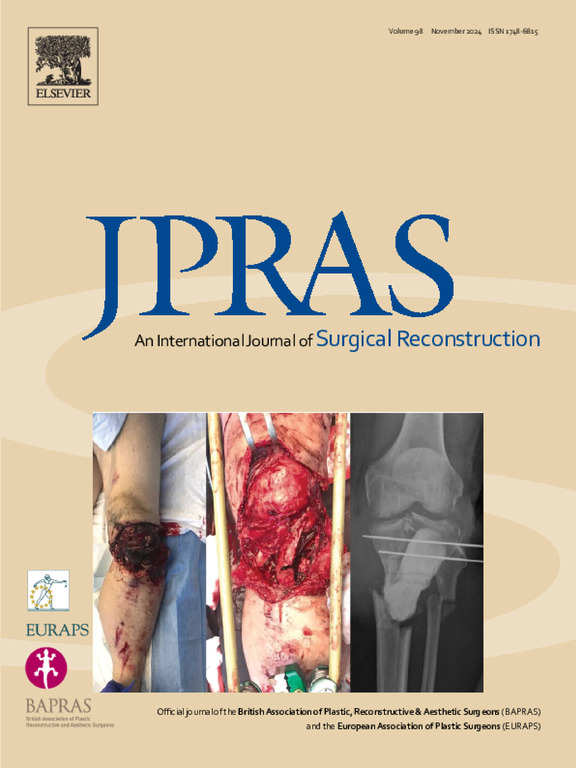头痛和神经痛患者的手术治疗延迟与术后效果不佳有关。
IF 2
3区 医学
Q2 SURGERY
Journal of Plastic Reconstructive and Aesthetic Surgery
Pub Date : 2024-09-19
DOI:10.1016/j.bjps.2024.09.058
引用次数: 0
摘要
简介:尽管神经减压手术已被证明能有效减轻头颈部神经痛和头痛疾病患者的症状,但目前它还不是头痛疾病治疗方案的一部分。因此,患者从出现症状到接受手术治疗平均需要等待 20 年,这导致了高昂的保守治疗费用(每位患者 989,275.65 美元)和患者发病率。本研究评估了治疗延迟对手术结果的临床影响:2012年9月至2024年1月期间在威尔康奈尔医学院和麻省总医院接受神经减压手术的282名患者被纳入研究。通过患者调查收集了有关人口统计学、发病症状和头痛特征的信息。治疗效果根据症状减轻的频率、持续时间和疼痛强度的百分比进行评估。为了确定接受手术的最佳时间点,还进行了受体操作特征下面积分析:结果:术后症状减轻率与症状出现和手术之间的时间呈负相关(r = -0.22;p 结论:我们的结果表明,延迟接受神经外科手术可能会导致患者疼痛加剧:我们的研究结果表明,从症状出现起超过 2.9 年才接受神经减压手术会导致术后效果不佳,这也强调了在保守治疗无效时及时转诊给周围神经外科医生的必要性。尽管如此,即使延迟手术治疗,患者的症状仍能明显减轻。本文章由计算机程序翻译,如有差异,请以英文原文为准。
Surgical treatment delay in patients with headache disorders and neuralgia correlates with poor postoperative outcome
Introduction
Although nerve decompression surgery has proven to be effective in reducing symptoms in patients with head and neck neuralgia and headache disorders, it is currently not part of the treatment algorithms for headache disorders. Therefore, patients wait an average of 20 years from the onset of symptoms to surgery, resulting in high conservative treatment costs ($989,275.65 per patient) and patient morbidity. This study evaluated the clinical impact of treatment delays on surgical outcomes.
Methods
Overall, 282 patients who underwent nerve decompression surgery at Weill Cornell Medicine and Massachusetts General Hospital between September 2012 and January 2024 were enrolled. Information regarding demographics, onset of symptoms, and headache characteristics was collected using patient surveys. The treatment outcome was evaluated by the percentage of symptom reduction in terms of frequency, duration, and pain intensity. An area under the receiver operating characteristic analysis was performed to determine the optimal timepoint to undergo surgery.
Results
Postoperative symptom reduction and time between the onset of symptoms and surgery were negatively correlated (r = −0.22; p < 0.001). The most significant difference in outcome was found at 2.9 years from symptom onset; patients who underwent surgery before this timepoint reported an average improvement of 79 ± 23% versus 67 ± 35% in those who were treated after the timepoint (p = 0.021).
Conclusion
Our results indicate that delays in undergoing nerve decompression surgery beyond 2.9 years from symptom onset leads to less favorable postoperative outcomes, underscoring the need for timely referral to peripheral nerve surgeons when conservative management fails. Nonetheless, even with delays in surgical intervention, patients continued to experience significant symptom reduction.
求助全文
通过发布文献求助,成功后即可免费获取论文全文。
去求助
来源期刊
CiteScore
3.10
自引率
11.10%
发文量
578
审稿时长
3.5 months
期刊介绍:
JPRAS An International Journal of Surgical Reconstruction is one of the world''s leading international journals, covering all the reconstructive and aesthetic aspects of plastic surgery.
The journal presents the latest surgical procedures with audit and outcome studies of new and established techniques in plastic surgery including: cleft lip and palate and other heads and neck surgery, hand surgery, lower limb trauma, burns, skin cancer, breast surgery and aesthetic surgery.

 求助内容:
求助内容: 应助结果提醒方式:
应助结果提醒方式:


